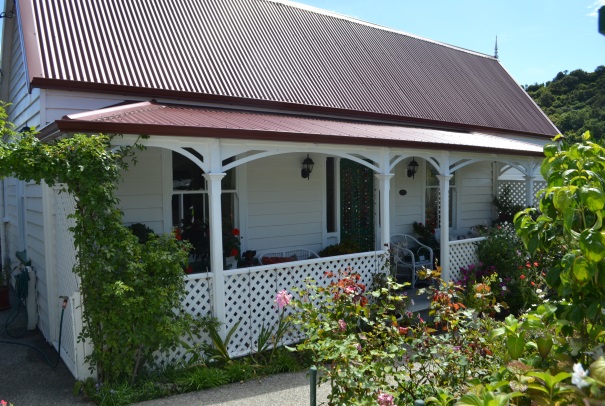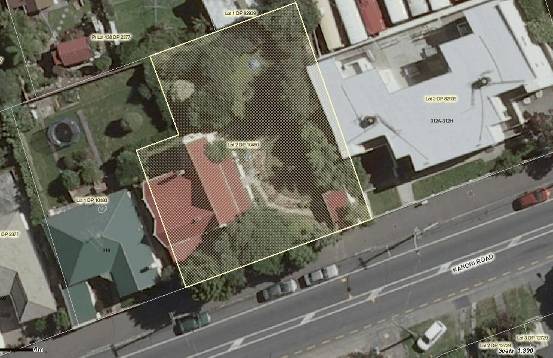Glendaruel
‘Glendaruel’
-
Constructed
c.1850
-
-
Architect(s)
-
Builder(s)
-
‘Glendaruel’ is an excellent example of an early pit sawn timber cottage. It is one of the oldest examples of a pit sawn timber dwelling in Wellington.
Glendaruel is a house of considerable age and historical significance, although part of its history is somewhat obscure. It was the home, for seven years, of the family of P.F.M. Burrows, one of New Zealand’s most prominent colonial architects in the 19th century. The family with the longest association with the house is the Woods. The house was bought in 1919 by the Rev. Robert Wood and remained in the family until recently.
This house is a good representative of an early put sawn cottage dating to before the turn of the century. It is constructed in materials, and using techniques, that were common to the period.
-
Downloadable(s)
-
close
History
-
‘Glendaruel’ is an early pit sawn timber cottage located on the main road of Karori. As a suburb, Karori was settled early in Wellington’s colonial history. The land that the cottage occupies was first farmed and occupied by Daniel Wright and his family. Upon Wright’s death in 1856 the land passed to the trustees of his estate. Wright’s will indicates that the land included a cottage and stables; it is unclear whether or not this is the cottage now known as Glendaruel.
The land was leased out for a number of years and in 1873 it was purchased by Stephen Lancaster, one of Karori’s largest landowners and an important local politician. By 1878 much of the present building was in place. It was accompanied by eight hectares of land (now subdivided). The first known occupier was P.F.M. Burrows, then chief architect in the Colonial Architect’s office. P.F.M. Burrows was among a number of people who leased the property from Lancaster. Following Lancaster’s death in 1899, the executors of his estate subdivided the land in 1908 and were offered for sale. Glendaruel is featured on the auction poster for the ‘Lancaster Estate’ of that year which has notice of ‘A very desirable home containing six rooms, stables, etc erected on Section Nos. 440 and 441 having a total frontage of 126 ft. 8in. to the Main Road’. In October 1910 lots 439-441 were sold to Henry Taylor Marshall, who on sold them to Charles Austin Briggs, Company Manager in May 1914. In February Angus Melville Polson acquired the land from the Briggs estate.
In May 1919 Charlotte Eliza Wood purchased the property and the land. Charlotte Wood was the daughter of Dr. James MacGregor, a Scottish Minister, who had been a professor in the Free Church Theological College in Edinburgh. Following the death of two children to tuberculosis, the family emigrated, and arrived in New Zealand on the Jessie Reedman. The family lived in Oamaru, where MacGregor became the first Minister of the Columba Church. Charlotte attended Otago University, where she graduated with an M.A with Honours and became a secondary school teacher. In 1904 Charlotte met Robert Wood, whom she married in 1906. Robert was born in Leith, Scotland in 1852. After working as a youth he became involved in the temperance movement, and whilst studying for his ordinance at the Free Church of Scotland he agreed to do missionary work and arrived in New Zealand in 1877. He spent time at the first Church in Dunedin and Masterton. He was a minister in Southland and North Canterbury, and also spent time in Island Bay and Seatoun. On Robert Wood’s retirement in 1919, the couple moved to Karori, where Robert would be active in the local church and community. The Wood’s home was named ‘Glendaruel’ after a town in Argyll, Scotland, with which Mrs Wood’s family had strong ties in the past.
The land was subdivided in 1929 and part of lot 439 was sold. In 1933 the land was divided into two lots, lot 1 was sold in 1934 to E.A. Wing and Charlotte Wood kept lot 2 and Glendaruel until her death, when it was transferred to Katherine Wood. It is around this time that that the major modifications were made to the house. In 1932 the rear wall was demolished and replaced with a washhouse, shed, and porch, as well as a new kitchen and bathroom. Material from the demolished sections was used to construct the additions. Other changes included changing the double chimney to a single chimney, the addition of a fireplace in the front bedroom, and the installation of new drainage. Four years later a new garage was built on the property, and in 1974 the house was repiled, and in 1975 the lean to room was demolished.
Glendaruel is a house of considerable age and historical significance, although part of its history is somewhat obscure. It was the home, for seven years, of the family of P.F.M. Burrows, one of New Zealand’s most prominent colonial architects in the 19th century. The family with the longest association with the house is the Woods. The house was bought in 1919 by the Rev. Robert Wood and remained in the family until recently.
-
Modifications
close
-
unknown
-
(original plans cannot be accessed)
-
1932
-
316 Karori Road, additions and alterations (00056:132:B11971)
-
1934
-
316 Karori Road [318 Karori Road], dwelling (00056:148:B13323)
-
1937
-
316 Karori Road, garage (00056:183:B16061)
-
1974
-
316 Karori Road, repile dwelling (00058:895:C39759)
-
-
Occupation History
close
-
unknown
-
Not assessed
-
-
-
close
Architectural Information
-
Building Classification(s)
close
Not assessed
-
Architecture
close
Glendaruel’ is an excellent example of a small colonial vernacular timber dwelling. It is one of the oldest examples of a pit sawn timber dwelling in Wellington. The house has a pitched roof and little decoration.
-
Materials
close
Glendaruel was constructed originally in timber piles which were replaced with pre cast concrete piles in 1974
Timber framing
Pit sawn shiplap weatherboards
Rusticated weatherboards
Corrugated iron roof
-
Setting
close
‘Glendaruel’ is an early pit sawn timber cottage located on the main road of Karori. As a suburb, Karori was settled early in Wellington’s colonial history. The house is obscured from the street by a number of trees and the main façade is not particularly prominent in the streetscape and the gable end of the house is on the street facing edge of the property.
-
Building Classification(s)
close
-
close
Cultural Value
‘Glendaruel’ is an excellent example of an early pit sawn timber cottage. It is one of the oldest examples of a pit sawn timber dwelling in Wellington.
Glendaruel is a house of considerable age and historical significance, although part of its history is somewhat obscure. It was the home, for seven years, of the family of P.F.M. Burrows, one of New Zealand’s most prominent colonial architects in the 19th century. The family with the longest association with the house is the Woods. The house was bought in 1919 by the Rev. Robert Wood and remained in the family until recently.
This house is a good representative of an early put sawn cottage dating to before the turn of the century. It is constructed in materials, and using techniques, that were common to the period.
-
Aesthetic Value
close
-
Architectural
Does the item have architectural or artistic value for characteristics that may include its design, style, era, form, scale, materials, colour, texture, patina of age, quality of space, craftsmanship, smells, and sounds?
‘Glendaruel’ is an excellent example of an early pit sawn timber cottage. It is one of the oldest examples of a pit sawn timber dwelling in Wellington.
-
Townscape
Does the item have townscape value for the part it plays in defining a space or street; providing visual interest; its role as a landmark; or the contribution it makes to the character and sense of place of Wellington?
Although ‘Glendaruel’ is located on the main road of Karori, it is obscured from the streetscape by a number of trees, so its townscape values are modest.
-
-
Historic Value
close
-
Association
Is the item associated with an important person, group, or organisation?
Glendaruel is a house of considerable age and historical significance, although part of its history is somewhat obscure. It was the home, for seven years, of the family of P.F.M. Burrows, one of New Zealand’s most prominent colonial architects in the 19th century. The family with the longest association with the house is the Woods. The house was bought in 1919 by the Rev. Robert Wood and remained in the family until recently.
-
Association
Is the item associated with an important historic event, theme, pattern, phase, or activity?
This house is one of the oldest examples of a pit sawn timber dwelling in Wellington and is associated with the early subdivision and settlement of Karori.
-
-
Scientific Value
close
-
Archaeological
Does the item have archaeological value for its ability to provide scientific information about past human activity?
This house was constructed pre-1900 so is an archaeological site. It is unknown what the risk of accidental discovery may be, but archaeological material from the early life of the house is probable.
-
-
Social Value
close
-
Identity Sense of place Continuity
Is the item a focus of community, regional, or national identity? Does the item contribute to sense of place or continuity?
This house contributes to the sense of place and continuity in Karori due to the retention of its original features and its long standing place on the street.
-
-
Level of Cultural Heritage Significance
close
-
Authentic
Does the item have authenticity or integrity because it retains significant fabric from the time of its construction or from later periods when important additions or modifications were carried out?
This house retains a significant amount of authenticity having had few exterior modifications.
-
Local Regional National International
Is the item important for any of the above characteristics at a local, regional, national, or international level?
This house is of local significance due to its association with P.F.M. Burrows and the Wood family. It is an excellent representative of an early cottage and retains significant authenticity.
-
Representative
Is the item a good example of the class it represents?
This house is a good representative of an early put sawn cottage dating to before the turn of the century. It is constructed in materials, and using techniques, that were common to the period.
-
-
Local / Regional / National / International Importance
close
Not assessed
-
Aesthetic Value
close
-
close
Site Detail
-
District Plan Number
11/166
-
Legal Description
Lot 2 DP 10480
-
Heritage New Zealand Listed
2/1365
-
Archaeological Site
Pre 1900 building
-
Current Uses
unknown
-
Former Uses
unknown
-
Has building been funded
No
-
Funding Amount
Not applicable
-
Earthquake Prone Status
Not Earthquake Prone
-
-
close
Additional Information
-
Sources
close
- Taylor, James. ‘316 Karori Road Wellington – Glendaruel.’ Unpublished registration report, 14 June 2006. Accessed 22 August 2013
- 1932 316 Karori Road, additions and alterations (00056:132:B11971)
- 1934 316 Karori Road [318 Karori Road], dwelling (00056:148:B13323)
- 1937 316 Karori Road, garage (00056:183:B16061)
- 1974 316 Karori Road, repile dwelling (00058:895:C39759)
-
Technical Documentation
close
Not available
-
Footnotes
close
Not available
-
Sources
close
Last updated: 10/24/2017 11:08:12 PM



